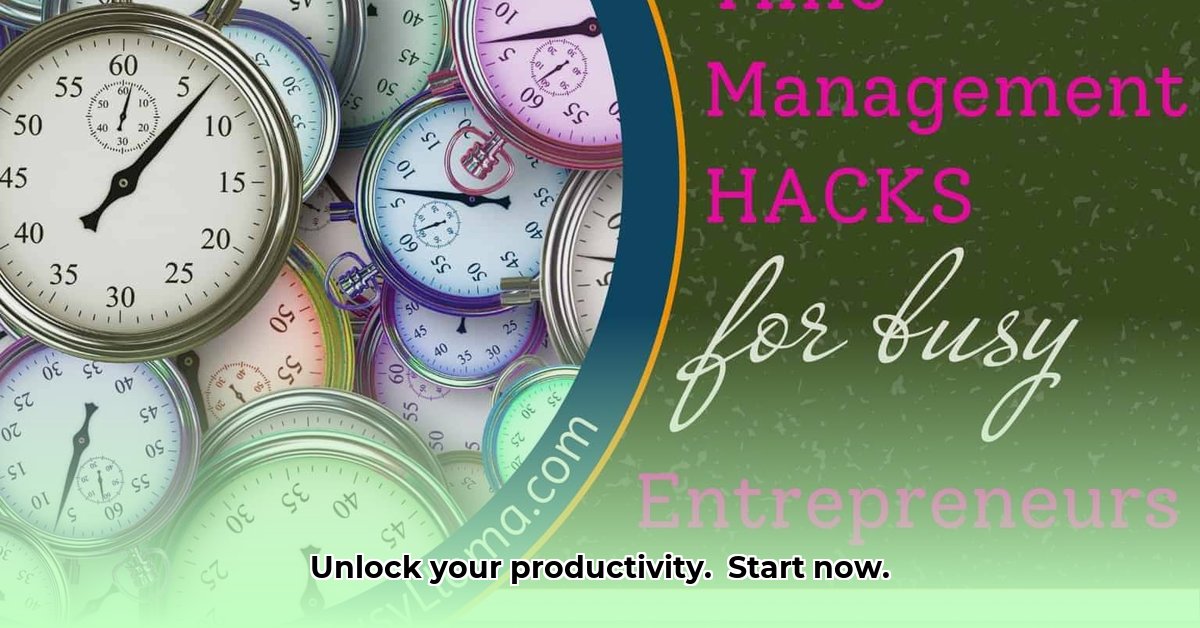Stressed out about keeping up with everything? Wish you could effortlessly balance work, family, and everything else? This guide is for you. We’re not just going to throw a bunch of time-management tips at you; we’ll walk you through practical strategies that actually work. We’ll cover popular techniques like the Pomodoro Technique and the Eisenhower Matrix, and show you how to create your own personalized system. You’ll learn why a plan tailored to you is key to long-term success and discover actionable steps to beat procrastination for good. For more in-depth time management principles, check out this helpful resource: Time Management Principles. Let’s get you organized and in control of your time!
Managing Time Effectively: Boost Your Productivity Now
Let’s face it: time slips away. We all wish we had more of it, but wishing doesn’t make it so. Mastering your time isn’t about cramming more into each day; it’s about making conscious choices about how you spend your hours. This guide offers practical strategies to help you take control, reduce stress, and achieve a better work-life balance.
Understanding Your Time: The Foundation of Effective Management
Before diving into time-management hacks, let’s get real. Where does your time actually go? It’s like creating a budget – you need to know where your money is going before you can manage it effectively. For a week, keep a simple log of everything you do. Include even the small stuff! Use a notebook, a spreadsheet, or a time-tracking app. Note the start and end times of each activity, even if it’s just checking social media or responding to an email. Be honest with yourself; this isn’t about judging, but measuring. You might be surprised by the time-suckers lurking in your day. This honest look at your habits is the foundation for real improvement.
Now analyze your time log. Calculate how many hours you spent on different categories of activities (work, leisure, chores, etc.). Identify your most time-consuming tasks and assess whether you’re investing your time in the most important activities.
Easy Wins: Quick Time-Management Tactics for Immediate Results
You don’t need a complete life overhaul to start managing your time better. Start with these easy-to-implement strategies for increased productivity:
- The Pomodoro Technique: This simple method involves working in focused 25-minute intervals, followed by a short 5-minute break. After four “Pomodoros,” take a longer 15-20 minute break. This technique is surprisingly effective at maintaining concentration and preventing burnout.
- The Eisenhower Matrix (Urgent/Important): This prioritization method helps you categorize tasks based on their urgency and importance. Draw a 2×2 matrix and label the quadrants: 1) Urgent and Important, 2) Important but Not Urgent, 3) Urgent but Not Important, and 4) Neither Urgent nor Important. Focus on the “Important and Urgent” tasks first. Schedule time for “Important but Not Urgent” tasks. Delegate or eliminate less critical items.
These methods are quick wins; they are easy to pick up and start seeing the results almost instantly.
Building Your Personalized Time Management System for Optimal Efficiency
Once you’ve practiced with simpler methods, it’s time for a more customized system. There’s no one-size-fits-all solution. It’s about blending techniques, finding what feels right for you, and adjusting along the way. Think of it as a continuous experiment!
Here are some key elements to consider incorporating:
- Set SMART Goals: Define both short-term and long-term goals that are Specific, Measurable, Achievable, Relevant, and Time-bound. Break down large goals into smaller, more manageable tasks. This makes big projects feel less overwhelming!
- Plan Ahead: Use a planner, calendar, app – whatever works for you. Planning your day or week in advance helps you stay organized and reduce decision fatigue. Schedule specific times for different tasks.
- Prioritize Ruthlessly: Regularly review your tasks and reassess priorities. What’s most important today? What can wait? Use the Eisenhower Matrix or a similar method to rank your tasks.
- Task Batching: Group similar tasks together. This minimizes context switching (the mental energy it takes to switch between different tasks) and allows for more focused work. For example, respond to all emails at once, or make all phone calls in a single block.
- Time Blocking: Allocate specific time slots for particular activities. This helps structure your day and ensures you’re dedicating sufficient time to important tasks. Be realistic about how much time each task will take.
- Delegate When Possible: Don’t be afraid to delegate tasks when appropriate. This frees up your time for higher priority items. If you’re a manager, delegate tasks to your team. If you’re at home, consider outsourcing chores like cleaning or laundry.
- Limit Multitasking: Focus on one task at a time. Studies show that multitasking reduces productivity and increases errors. Concentrate on completing one task fully before moving on to the next.
Level Up: Advanced Time Management Strategies for Peak Performance
As you become more comfortable with the basics, consider these more advanced techniques for optimized time use:
- Project Management Software: Tools like Trello, Asana, or Monday.com can help with complex projects and collaborations. These tools offer features like task assignment, progress tracking, and shared calendars.
- Pareto Principle (80/20 Rule): This suggests that 80% of your results come from 20% of your efforts. Identify those high-impact activities and focus your energy there. What are the 20% of your tasks that generate the most significant results?
- Eat the Frog: Tackle your most challenging or unpleasant task first thing in the morning. This gets it out of the way and frees you to focus on other tasks.
- Two-Minute Rule: If a task takes less than two minutes, do it immediately. This prevents small tasks from accumulating and becoming overwhelming.
- Advanced Time Blocking: Explore more sophisticated time-blocking strategies, such as incorporating buffer time or prioritizing tasks based on your energy levels throughout the day. Schedule your most demanding tasks for when you’re most alert and focused.
Remember, there’s no magic solution, and the best approach is always personalized. Continuous review and adjustment are key. Experiment and adapt to find what works best for you.
Technology: Helpful Tool or Time Thief for Efficient Task Management?
Technology can be a fantastic aid in managing your time effectively, but it’s a double-edged sword. Apps and software can help you plan, track progress, and collaborate. However, constant notifications and endless scrolling can easily derail our focus and increase stress.
| Technology Tool | Potential Benefits | Potential Downsides | Mitigation Strategies |
|---|---|---|---|
| Time Tracking Apps | Data-driven insights, improved accountability | Potential for over-reliance, privacy concerns | Use selectively, focus on self-discipline. Set time limits for specific tasks. |
| Calendar & Scheduling Apps | Organization, reminders, integration with other tools | Notification overload, potential for over-scheduling | Optimize notifications, use color-coding, declutter. Schedule buffer time between meetings. |
| Project Management Tools | Collaboration, task management, progress tracking | Complexity, learning curve, potential for micromanagement | Start simple, seek training if needed. Clearly define roles and responsibilities. |
| Social Media Apps | Staying connected, entertainment | Time-wasting, distraction, reduced focus | Set time limits, use website blockers, turn off notifications. |
| Communication, information sharing | Time-consuming, interruption, inbox overload | Schedule specific times for checking email, use filters, unsubscribe from unnecessary lists. |
Work-Life Integration: The Key to Sustainable Productivity and Well-being
Effective time management isn’t just about boosting productivity; it’s about creating a sustainable, fulfilling life. Don’t forget to schedule downtime! Make time for hobbies, social connections, and relaxation. Burnout is a serious issue; neglecting self-care will impact your productivity in the long run. Guard your personal time as you would your work time. A balanced, well-rested you is a more productive you. Schedule regular breaks throughout the day, get enough sleep, and eat a healthy diet.
How to Choose the Best Time Management Technique for My Personality Type
Finding the perfect time management system feels like searching for a mythical unicorn, doesn’t it? But the truth is, the most effective system is the one you can stick with. How to choose the best time management technique for my personality type is the key question.
Understanding Your Work Style: The First Step
Before diving into specific techniques, take a moment for honest self-reflection. What are your strengths? What are your weaknesses? Are you a morning person, or do you hit your stride in the afternoon? Do you thrive on structure or prefer flexibility? Are you detail-oriented or more big-picture focused? Answering these questions reveals your natural work style. This is the foundation for selecting the right time management system.
Consider taking a personality assessment like the Myers-Briggs Type Indicator (MBTI) or the Enneagram. These assessments can provide insights into your preferences and tendencies, helping you understand how you approach tasks and manage your time.
Popular Time Management Techniques: A Quick Overview
Several well-known techniques can help you conquer your to-do list. Let’s briefly examine a few:
- The Pomodoro Technique: Work in focused bursts (e.g., 25 minutes) followed by short breaks. This method is great for those who struggle with sustained concentration. It’s also helpful for breaking down large tasks into smaller, more manageable chunks.
- Eisenhower Matrix (Urgent/Important): Prioritize tasks based on urgency and importance. Delegating or eliminating less critical items becomes easier. This works well for those needing clear prioritization and helps prevent you from getting bogged down in less important activities.
- Getting Things Done (GTD): A comprehensive system involving capturing, clarifying, organizing, reflecting, and engaging with tasks. This system suits those who like detailed organization but might feel overwhelming to others. It’s best for those who enjoy structure and have a strong attention to detail.
- Time Blocking: Schedule specific blocks of time for particular tasks. This is ideal for highly structured individuals who thrive on routine and predictability.
Matching Techniques to Personality Types for Increased Productivity
Let’s explore matching personality types with techniques. Remember, these are general guidelines; feel free to experiment and adapt.
- The Planner: These individuals thrive on structure and predictability. Time Blocking, combined with a detailed calendar and to-do list, is their ideal match. They often benefit from using project management software to organize complex projects.
- The Free Spirit: Those who prefer flexibility might find the Pomodoro Technique beneficial, allowing for focused work with breaks for spontaneity. They may also prefer a more visual approach to time management, like using a mind map.
- The Procrastinator: The Eisenhower Matrix helps prioritize tasks, allowing them to tackle the most pressing items first, minimizing procrastination’s impact. Breaking down large tasks into smaller, more manageable steps can also help overcome procrastination.
- The Multitasker: While multitasking is generally discouraged, some individuals thrive on it. If you’re a natural multitasker, try batching similar tasks together and allocating specific time blocks for each batch. Be mindful of your energy levels and avoid overloading yourself.
- The Perfectionist: Perfectionists often struggle with completing tasks due to their fear of failure. The Eisenhower Matrix can help them prioritize tasks and focus on the most important ones. Setting realistic deadlines and breaking down tasks into smaller steps can also help overcome perfectionism.
Building Your Personalized System for Maximum Efficiency
Once you’ve experimented with a few techniques, it’s time to create your tailored system. This might involve a potent mix of strategies. For example, you could use time blocking for crucial meetings, the Pomodoro Technique for deep work, and the Eisenhower Matrix for daily task prioritization. It’s about creating a system that enhances your strengths and counteracts your weaknesses.
Technology: A Tool, Not a Master for Time Management
Technology can be your best friend or your worst enemy in time management. Smart use of productivity apps, calendar functions, and task lists fosters efficiency. However, constant notifications and the allure of social media can derail your progress. Set boundaries. Schedule specific times for checking emails and avoid multitasking. Use website blockers to limit distractions.
Consistent Application and Adaptation
Remember, consistency is key. Even the best system will fail if you don’t use it consistently. However, be prepared to adapt. Your needs and priorities change over time. Regularly review and refine your system to keep it relevant and effective. Schedule weekly reviews to assess your progress and identify areas for improvement.
Personalized Time Management Strategies for Students
Let’s face it: One size doesn’t fit all when it comes to managing your time. What works for your roommate might leave you feeling overwhelmed. That’s why personalized time management strategies for students are key.
Understanding Your Unique Needs as a Student
Think of it like finding the perfect pair of shoes—you wouldn’t wear someone else’s, would you? Start by identifying your learning style. Are you a morning person or a night owl? Do you thrive on structure or prefer a more flexible approach? Are you an auditory, visual, or kinesthetic learner? Knowing this helps you build a system that fits your rhythm.
Consider your academic workload, extracurricular activities, and social commitments. How much time do you need to dedicate to each area? Be realistic about your time constraints and priorities.
Mastering the Art of Prioritization for Academic Success
Juggling classes, assignments, extracurriculars, and a social life is a constant balancing act. Learning to prioritize is non-negotiable. The Eisenhower Matrix (urgent/important) is a helpful tool here. But don’t just passively use it; actively reflect on your tasks. What truly needs your immediate attention? What can wait? And what, frankly, can be delegated or eliminated entirely? Focus on assignments that have the highest impact on your grades or are due soonest.
Embrace the Power of “Chunking” Complex Tasks
Large assignments can feel daunting. Break them into smaller, manageable chunks. This eliminates overwhelm. For example, instead of thinking “write a 10-page paper,” think “outline today, write introduction tomorrow, research next week.” This makes the whole process far less intimidating, and much more achievable. Create a detailed outline of your tasks and set deadlines for each chunk.
The Pomodoro Technique: Your Focus Friend for Studying
The Pomodoro Technique is a simple yet incredibly effective method. Work in focused bursts (typically 25 minutes), followed by a short break. This structured approach combats the natural ebb and flow of concentration. Experiment with different work/break intervals to find what works best for you. This is crucial for maintaining optimal focus. Remember, your personalized system matters most. Try 50-minute work intervals followed by 10-minute breaks for a longer concentration span.
Taming the Tech Beast for Focused Study Sessions
Technology can be a double-edged sword. Smartphones, social media, and notifications are constant distractions. However, technology can also be a powerful tool. Use calendar apps to schedule classes and study time, to-do list apps to track assignments, and website blockers to curb procrastination. The key is mindful usage. Don’t let technology control you; control it. Turn off notifications, use website blockers, and schedule specific times for checking social media.
Building Your Personalized System for Student Success
- Assess Your Current Time Usage: Track your activities for a week to pinpoint time-wasters. Use a time-tracking app or a simple spreadsheet to monitor your activities.
- Set Realistic Goals: Don’t try to overhaul everything at once. Start with small, achievable goals.
- Choose Your Tools: Select a calendar, planner, or app that suits your style. Experiment with different tools to find what works best for you.
- Create a Weekly Schedule: Block out time for classes, study, extracurriculars, and relaxation. Be sure to schedule enough time for sleep and meals.
- Review and Adjust: Regularly evaluate your system and adapt as needed; flexibility is key. Don’t be afraid to make changes to your schedule and strategies.
Beyond the Schedule: Self-Care is Non-Negotiable for Student Well-being
Remember, effective time management isn’t just about productivity; it’s about well-being. Schedule in time for exercise, relaxation, and socialization. Burnout is a real threat, and self-care is your best defense. These practices are more than just nice-to-haves; they are vital components of a sustainable study plan. Prioritize sleep, exercise, and healthy eating.
Effective Time Management Techniques for Remote Teams
Remote teams face unique challenges when it comes to time management. Distractions at home, communication barriers, and the lack of a traditional office environment can make it difficult to stay focused and productive. Effective Time Management Techniques for Remote Teams are crucial for success.
Time Blocking: Your Daily Schedule’s Best Friend for Remote Work
Think of time blocking as creating a personalized roadmap for your day. Schedule specific blocks of time for particular tasks. Want to dedicate an hour to focused writing? Schedule it. Need time for emails? Block it off. This structured approach prevents task-switching, boosts concentration, and ultimately, increases your output. Ensure that team members share their time blocks with each other to promote transparency and coordination.
Prioritization: The Art of Saying “No” to Distractions
Tackling the most important tasks first—the “Eat the Frog” method —can dramatically change your day. Use the Eisenhower Matrix (urgent/important) to categorize your tasks. Focus on important, non-urgent tasks to prevent future crises. Remember, saying “no” to less critical requests safeguards your time for what really matters. Encourage team members to communicate their priorities and availability to each other. Clear communication is key to effective prioritization. Learning to prioritize is a crucial Effective Time Management Techniques for Remote Teams.
The Pomodoro Technique: Short Bursts of Focused Energy for Remote Collaboration
This popular technique involves working in 25-minute intervals (Pomodoros) followed by short breaks. It leverages the power of short, focused sprints. Try it: you might be surprised by how much you can achieve. The key is consistency. This technique can be adapted for team collaboration by scheduling group Pomodoro sessions where team members work on individual tasks but remain available for quick questions or check-ins.
Boundaries: Protecting Your Time and Well-being in Remote Settings
Working remotely blurs the lines between work and personal life. Setting clear boundaries is vital. Establish specific work hours and stick to them. Designate a separate workspace, free from distractions. This physical and mental separation helps maintain a healthy work-life balance – a crucial aspect of Effective Time Management Techniques for Remote Teams. Encourage team members to communicate their boundaries to each other and respect each other’s personal time.
Technology: A Tool, Not a Tyrant in the Remote Workspace
Technology can be incredibly helpful, but it can also be a massive time-suck. Avoid constant notification checks. Use website blockers for distracting sites. Master your tools, and they’ll work for you, not against you. Utilize project management software, video conferencing tools, and collaboration platforms to streamline workflows and enhance communication.
Regular Review and Adjustment: The Key to Long-Term Success
Your schedule and strategies aren’t set in stone. Regularly review your time management system. What works? What doesn’t? Adjust accordingly. This iterative process ensures continued improvement and prevents burnout. A flexible approach allows you to adapt to changing needs and priorities. This continuous refinement guarantees that your Effective Time Management Techniques for Remote Teams always remain effective and up-to-date. Schedule regular team meetings to discuss time management strategies, share best practices, and identify areas for improvement.
https://summer.harvard.edu/blog/8-time-management-tips-for-students/
- How To Balance Coaching And Personal Life For Well-Being - January 6, 2026
- Work Life Balance Coach Transforms Stress into Sustainable Well-being - January 5, 2026
- Work-Life Balance Solutions: Strategies for Achieving Personal and Professional - January 4, 2026
















